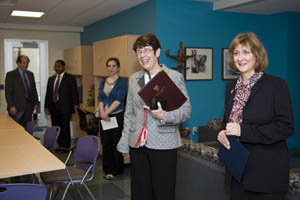 |
Home | Contact Us | A to Z |
 |
New Green Facility Opens for Chronically Homeless
After living on the streets for more than 20 years, doing time for drug dealing and losing custody of his children, Ernest Lowery is turning his life around. He moved to the Connelly House in December 2010 and has been reinventing himself ever since. "I think the program is a stepping stone, because when I finished my last program, I was not ready to live independently on my own," Lowery said. "The staff believes in me when I don't believe in myself." Now studying for his GED, taking parenting classes and working at Citizen's Bank Park, Lowery is just one example of how the Connelly House is changing lives. The new facility, located at 1212 Ludlow Street in Philadelphia offers 79 formerly homeless men and women temporary housing. Though its doors opened last winter, the building celebrated its grand opening on May 17, 2011. "We must end homelessness," Mayor Michael Nutter said at the ribbon-cutting ceremony. "We can solve this challenge and there's no other city better prepared to do it than Philadelphia."
The Connelly House, developed and run through a partnership between Project H.O.M.E. and the Bethesda Project, is composed of eight stories of environmentally-sustainable housing. Boasting an energy-efficient green roof and earning a U.S. Green Building Council LEED Silver Certification, the facility was funded by both federal and state agencies. The project cost more than $20 million total, with $8.6 million supplied by HUD which will also be providing $4.3 million over the next decade to help fund the building's operating costs. "Never before has there been a national strategic plan to end homelessness. There is one today," said Jane Vincent, HUD Mid-Atlantic Regional Administrator. "It's because of the folks in this room that [Philadelphia is] looked at as a model across the country as we work to end homelessness."
Both Project H.O.M.E. and the Bethesda Project have been fighting to end homelessness for decades. Each organization serves the chronically homeless with temporary or permanent residences and shelters throughout the Philadelphia region. Sister Mary Scullion, co-founder of Project H.O.M.E., stressed the importance of building a community to empower the formerly homeless, instead of simply enabling them. "A home is more than a place where people live," she said.
|
||||
| Content Archived: January 23, 2013 | ||||




